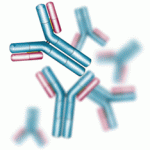Immunology
|
16 july 2014 01:36:23 |
| Role of toll-like receptors in human iris pigment epithelial cells and their response to pathogen-associated molecular patterns (Journal of Inflammation) |
|
Tweet Background:
Toll-like receptor (TLR) activation is hypothesized to contribute to inflammatory eye disease including uveitis, yet the distribution pattern of TLRs in human uveal tissues remains poorly described. The purpose of this study was to investigate the expression profile of TLRs in human iris pigment epithelial cells (IPE) at the gene and protein level and examine the effect of pathogen-associated molecular patterns (PAMPs), such as Pam3CSK4.3HCl, Poly(I:C), lipopolysaccharides (LPS from E. coli serotype O111:B4), Flagellin, MALP-2 (macrophage activating lipopeptide-2), Poly(U) and CpGODN2395 on the production of inflammatory mediators including interleukin-8 (IL-8) and monocyte chemotactic protein 1 (MCP-1) from human IPE and retinal pigment epithelial cells (RPE).
Methods:
RT-PCR and Western blotting was employed to investigate the expression of TLRs 1-10 in primary IPE and RPE. Secretion of IL-8 or MCP-1 following treatment with PAMPs was measured by ELISA. The role of TLR2, TLR3 and TLR4 in mediating an inflammatory response was investigated using pharmacological TLR inhibitors.
Results:
IPE and RPE expressed transcripts for TLR1-6 and 8-10; and proteins for TLR1-6 and 9. IPE secreted IL-8 or MCP-1 in response to Pam3CSK4.3HCl, Poly(I:C), LPS and MALP-2, whereas RPE produced IL-8 only after Poly(I:C), LPS or MALP-2 treatment. TLR inhibitors (OxPAPC, CI-095 and chloroquine) blocked IL-8 secretion in Poly(I:C), LPS or MALP-2-treated IPE and RPE.
Conclusions:
Ocular pigment epithelial cells respond to PAMPs through activation of TLRs, particularly TLR2, TLR3 and TLR4. Expression of TLRs in human IPE cells provides a basis for responses to many ocular pathogens and their activation may be involved in the pathogenesis of ocular inflammation. |
| 70 viewsCategory: Immunology |
 Heat shock protein 70 down-regulates the production of toll-like receptor-induced pro-inflammatory cytokines by a heat shock factor-1/constitutive heat shock element-binding factor-dependent mechanism (Journal of Inflammation) Heat shock protein 70 down-regulates the production of toll-like receptor-induced pro-inflammatory cytokines by a heat shock factor-1/constitutive heat shock element-binding factor-dependent mechanism (Journal of Inflammation)Writing well: lowering the barriers to success (Nature Immunology) 
|
| blog comments powered by Disqus |
MyJournals.org
The latest issues of all your favorite science journals on one page
The latest issues of all your favorite science journals on one page



